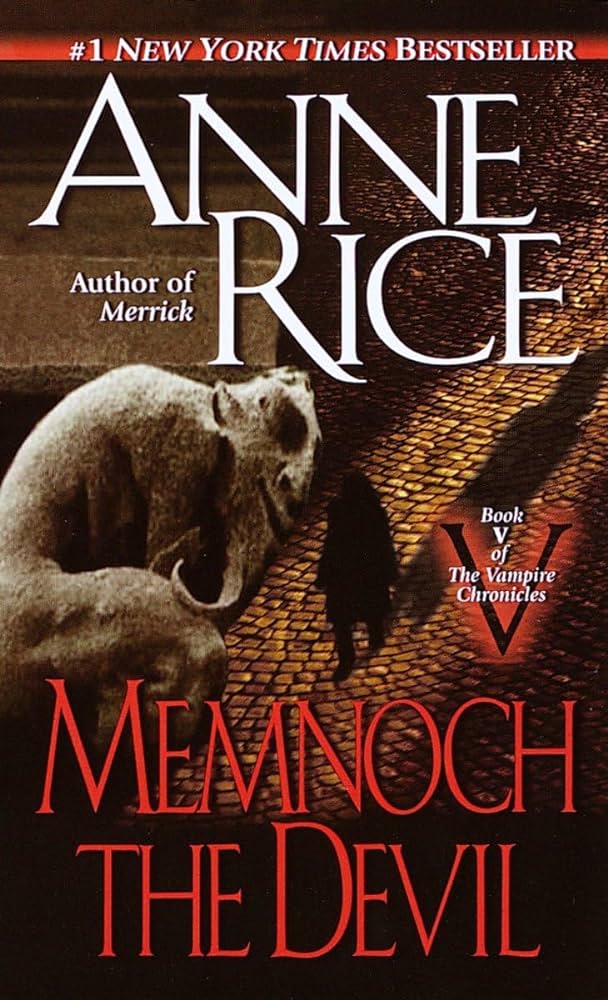Spoilers:
- Lestat meets God and the Devil
- Devil says they’re teammates with God
- Lestat given choice to become a devil
- Memnoch might be manipulating Lestat
- Lestat steals Veronica’s veil
- Debate on Heaven’s and Hell’s design
- Lestat questions human existence
Statistics for “Memnoch the Devil”
Book Details
- Author: Anne Rice
- Series: The Vampire Chronicles #5
- Published: July 1995
- Publisher: Alfred A. Knopf
- Genre: Gothic horror, philosophical literature
Key Characters
- Lestat de Lioncourt: Protagonist, vampire
- Memnoch: Antagonist, the Devil
- Dora: Television evangelist, crucial human character
- Roger: Lestat’s victim, becomes a ghost
Themes
- Good vs Evil
- Religious conflict
- Existence of God and Devil
- Moral ambiguity
Sales and Reception
- Bestseller: Yes
- Critical Reception: Mixed reviews
Praised for philosophical depth, criticized for narrative pace.
Key Plot Points
- Lestat meets Memnoch, offered tour of Heaven and Hell
- Exploration of fear, faith, and despair
- Memnoch’s claim of being “God’s adversary”
- Dora’s role in unveiling truth
Impact on Series
- Pivotal in expanding theological discussions
- Deepened Lestat’s character arc
Marked a shift towards more abstract themes in series.
“Memnoch the Devil” by Anne Rice, fifth in The Vampire Chronicles, is a compelling divine tableau, breaking boundaries of traditional religious thought. The novelist elegantly navigates a provocative existential maelstrom, presenting an alternative theological interpretation with her characteristic depth and intricate emotional astuteness. The protagonist, the wildly charismatic yet deeply tormented vampire Lestat, is led through an ontological journey by Memnoch, known to us as the Devil. Their journey transcends time, space and death, offering evocative glimpses of biblical events and God’s grand plan. Rice’s alluring and provocative narrative explores profound themes of faith, philosophy, and ethics, weaving a disconcerting dance between fact, fable, and fantasy. Expertly maneuvering the line between blasphemy and epiphany, Rice invites readers to grapple with existential conundrums. Lestat, not merely a passive observer, ultimately embodies human questioning and spiritual vulnerability, encapsulating the quintessence of fallen humanity.In the backdrop of divine bickering, Rice crafts a plausible reflection of consciousness where evil appears as an inevitable byproduct of choice and free will. Memnoch’s unconventional yet reasonable logic challenges orthodox religious beliefs, thereby prompting introspection, discomfort, even revelation, forcing us to question the dialectics of good and evil, heaven and hell.The brilliance lies in Rice’s ability to intertwine secular skepticism with holy reverence, thus turning “Memnoch the Devil” into a mystical, spiritual journey. It is a captivating philosophical exploration, a profound immersion into the heart of God – a masterpiece that begs contemplation long after the last page is turned. This novel will undeniably serve a deliciously disquieting and thought-provoking feast to those who dare to delve beyond the facade of religious dogma and into the expansive universe of divine conceptualizations.
Introduction to Memnoch the Devil
“Memnoch the Devil” is the fifth installment in Anne Rice’s acclaimed series, The Vampire Chronicles, published in 1995. The book captures the imagination with its blend of religion, philosophy, and horror. The story centers around the vampire Lestat, who is taken on a thought-provoking journey by none other than the Devil himself, Memnoch.
This novel stands out for its theological provocations and existential inquiries. Rice delves deep into the classic battle between good and evil. Some consider the work as Rice’s own exploration of spirituality and doubt. It’s likely inspired by her personal journey back to Christianity which she had left earlier in her life.
Interesting Facts and Speculation
- Memnoch portrays God and the devil with uncharacteristic, ambiguous morality.
- The novel includes a vivid reinterpretation of Biblical events.
- Rice claimed the book was emotionally exhausting to write, hinting at its personal significance.
Bizarre and Interesting Aspects
Many readers found the depiction of Heaven and Hell and the fleshing out of religious figures both bizarre and thought-provoking. Lestat’s interactions with Memnoch reveal a curious dynamic, blurring the lines between salvation and damnation. The narrative’s depiction of Hell incorporates elements of human suffering, capturing the visceral horror Rice is known for.
Public Perception Over Time
Initial reactions to “Memnoch the Devil” were mixed. Some praised Rice’s audacity and the depth of her spiritual themes. Others criticized its heavy philosophical tone, claiming it overshadowed the plot. Previously loyal fans of The Vampire Chronicles expressed discomfort with the book’s religious intensity.
Over time, perspectives shifted. Modern readers often view it as an underappreciated work, notable for its ambition and daring. Critics now appraise it as an introspective journey rather than just a horror story. Today, it’s frequently discussed for its complex take on morality, good, and evil.
Memnoch the Devil: A Punchy Beat-by-Beat Run-Down
Lestat’s New Target: Vamp Lestat eyes a dapper dandy for dinner. Plot twist: The prey, Roger, is a wealthy artifact dealer with a dark side.
Roger’s Downfall: Lestat dives in for the kill, uncovering Roger’s twisted backstories, including his dealings with sacred artifacts.
Daughter Drama: Enter Dora, Roger’s devout daughter. She’s a religious TV star with as much spirit as her dad had sins.
Spectral Visitor: Memnoch, the Devil himself, corners Lestat. Offers a tour of Heaven, Hell, and history. Sounds cool, right?
The Grand Tour: Lestat hits the supernatural road with Memnoch. Witnesses Creation, angels rebelling, and the dawn of humanity. Mind-blown yet?
Heavenly Debates: Lestat gets the lowdown on God vs. Devil, the ultimate family feud. Spoiler: It’s complicated.
Veronica’s Veil: Holy relic alert. Lestat snags Veronica’s Veil. Supposedly shows Jesus’ face. Memnoch’s gift or a curse?
Lestat’s Choice: To serve Memnoch or not? Heaven’s gates or Hell’s fury? Lestat’s indecision is as epic as his ego.
Back to Earth: Reality check. Lestat’s back, Veil in hand, missing an eye but not his flair. The world’s a stage, and Lestat’s still its star.
Dora’s Miracle: Lestat plays benefactor, gifting Dora the Veil. Miracles ensue, faith is restored, and the masses are mesmerized.
The Aftermath: Was it real or hallucination? Lestat’s left wondering, with only his eternal existence for company.
- Final Beat: Lestat ponders mortality vs. immortality, good vs. evil, and his place in a world that’s always been shades of grey.

Understanding Memnoch the Devil
Memnoch the Devil is a complex novel by Anne Rice, featuring a narrative that dives deep into themes of faith, doubt, and morality. The book challenges the reader with philosophical questions framed within a supernatural thriller.
Story Opening
The story opens with the character of Louis de Pointe du Lac, who is a vampire struggling with his existence. The opening sets a dark, melancholic tone, immediately establishing a mood of conflict within the protagonist. The language is direct, conveying Louis’s despair and grappling with existential questions. The opening also hints at a larger confrontation between good and evil, introducing the theme of duality that permeates the narrative.
Story Formula Breakdown
Memnoch the Devil employs a blend of classic narrative structure and philosophical exploration. The story adheres to a loose formula:
- Exposition: Introduction of characters and the protagonist’s inner turmoil.
- Rising Action: Louis’s encounters with Memnoch, the devil, introduce conflict.
- Climax: The philosophical battle between Louis and Memnoch over the nature of God and evil.
- Falling Action: Resolution of Louis’s internal conflict and revelations about his nature.
- Resolution: Conclusion of Louis’s journey and his acceptance of his existence.
Character vs. Story Driven
The story is more character-driven than plot-driven. Louis’s emotional and spiritual journey is at the heart of the narrative. The interactions with Memnoch provide a framework that enhances his character development, pushing him into philosophical realms that reshape his identity. The plot exists primarily to serve these character explorations.
Memorable Character Aspects
Louis is memorable for his depth and vulnerability. He embodies the struggle of an individual seeking meaning in a chaotic world. His internal conflicts, along with the philosophical dilemmas presented by Memnoch, create a robust character study. The anguish Louis feels is palpable and relatable, making his journey compelling.
Main Characters
- Louis de Pointe du Lac: The protagonist, a vampire who grapples with the morality of his existence.
- Memnoch: The devil, who challenges Louis’s perceptions of God, evil, and free will.
- Claudia: A child vampire, representing innocence lost and the complexities of eternal life.
- Lestat de Lioncourt: Louis’s maker, whose perspective on immortality contrasts sharply with Louis’s sorrow.
- God: Though not a physical character, God’s representation weighs heavily in the narrative as a focal point for Louis and Memnoch’s debates.
Template for Story Flow
1. Opening Scene: Establish protagonist’s internal conflict.
2. Introduction of Secondary Characters: Present characters that will influence the protagonist.
3. Inciting Incident: A meeting or event that thrusts the protagonist into a conflict.
4. Exploration of Themes: Layer in philosophical or moral dilemmas.
5. Climactic Confrontation: The protagonist faces the main challenge or antagonist.
6. Character Revelation: The protagonist learns a lesson or undergoes a transformation.
7. Falling Action: Show the aftermath of the climactic event.
8. Resolution: Conclude the character’s journey, reflecting on what has been learned.
Simple Story Summary
In simple terms, Memnoch the Devil is about a vampire named Louis who confronts the nature of good and evil through his interactions with Memnoch, the devil. The story explores themes of faith, redemption, and the quest for meaning in a world that often seems devoid of purpose. Louis’s journey is largely about understanding his existence and finding balance in the duality of his nature.
Throughout the Novel
Anne Rice’s Memnoch the Devil offers a rich tapestry of ideas and characterizations. The blend of horror and philosophy invites readers to ponder deep questions while following the tumultuous journey of Louis de Pointe du Lac. The narrative remains relevant, often provoking thought about the nature of existence and the moral choices individuals must face.
Further Analysis of Characters
Louis represents humanity’s struggle with identity and morality. He embodies the suffering artist archetype, constantly searching for answers. His introspection sheds light on the eternal human quest for understanding in a seemingly indifferent universe.
Memnoch, on the other hand, is an intriguing character that blurs the lines between villain and teacher. As the devil, he presents arguments that challenge conventional beliefs about good and evil, prompting readers to question their own preconceptions. This makes him a formidable foil to Louis, as he forces the vampire to confront truths he would rather ignore.
Claudia’s character is tragic. A child trapped in the body of a vampire, she symbolizes loss of innocence and the often-painful experience of eternal life. Her dynamic with Louis adds a layer of complexity, showcasing the emotional ramifications of vampirism.
Lestat, while less central to this novel, still serves to contrast Louis’s introspective nature with his own flamboyance. Lestat embodies the carefree embrace of vampiric power, further intensifying Louis’s internal struggles.
Philosophical Undertones
At its core, Memnoch the Devil poses critical questions about the nature of divinity. Through Louis’s dialogue with Memnoch, readers are led to ponder the existence of free will and the inherent darkness within humanity. The story critiques the traditional view of a just and omnipotent deity, suggesting instead that understanding one’s own capacity for evil is pivotal to grasping the essence of being human. This tension adds layers to the characters, making their journeys resonate deeply.
The Role of Narrative Techniques
Rice employs first-person narration effectively, allowing readers to seep into Louis’s mind. This technique creates intimacy and fosters empathy. Her use of rich but succinct prose evokes the gothic atmosphere of New Orleans while having a contemporary freshness that keeps the reader engaged. Each scene is carefully crafted to peel back layers of character and theme rather than simply pushing a plot forward.
Symbolism is prevalent throughout the novel. Memnoch himself can be seen as a representation of the dark side of humanity – our desires, questions, and inherent struggles with ethical dilemmas. The settings, from dark alleys to grand theaters, reflect the duality at play within Louis and hint at the pervasive conflict between light and dark.
Emotional Impact
The emotional weight of Memnoch the Devil lingers long after the last page is turned. Readers are left with unresolved feelings and questions, symbols of the complexities of faith and doubt. Louis’s plight resonates, serving as a reminder that searching for meaning is a fundamental part of the human experience, whether in the context of spirituality or personal identity.
Universal Themes
The universal themes of love, loss, faith, and the quest for redemption are threaded throughout the narrative. By focusing on the character’s ordeals rather than purely an adventurous plot, Rice successfully establishes a emotional and philosophical landscape that transcends time and space, inviting readers of all backgrounds to find solace and reflection in the pages.
Ultimately, Anne Rice’s Memnoch the Devil stands as a significant work that intertwines supernatural elements with profound philosophical inquiries. It forces readers to confront their own beliefs about good, evil, and the gray areas in between, leaving a lasting impact that questions what it truly means to exist.
Inciting Incident
The inciting incident in “Memnoch the Devil” occurs when Lestat meets Memnoch. This moment shifts Lestat’s life from one of existential boredom to a dramatic exploration of good and evil.
Symbolically, Memnoch represents temptation and the duality of existence. He challenges Lestat’s understanding of God and the Devil, forcing him to confront his own beliefs.
Act Structure
The novel generally follows a three-act structure.
- Act One: Introduces Lestat’s life of excess and boredom. Lestat’s brooding nature is highlighted through his interactions with mortals and other vampires. The act sets up Lestat’s need for purpose.
- Act Two: This act encompasses Lestat’s journey with Memnoch. As they travel through heaven and hell, the narrative expands on philosophical debates and moral questions. Key moments include Lestat witnessing the soul’s struggle and the fall of man.
- Act Three: The climax occurs as Lestat confronts the true implications of free will. This act emphasizes Lestat’s choice between accepting Memnoch’s view or returning to his previous life.
Climax
The climax is Lestat’s final confrontation with Memnoch, where he must choose between serving him or rejecting his vision of God. This moment is rich in emotional capital as Lestat grapples with identity, purpose, and morality.
The build-up involves Lestat’s growing disillusionment with the world and his increasing intrigue with Memnoch’s perspective. Tension escalates as Lestat faces moral dilemmas and questions his beliefs about existence.
Tension and Release
The book builds tension through philosophical discussions and Lestat’s internal conflict. Each encounter with Memnoch heightens the stakes, pushing Lestat deeper into a crisis of faith.
Release often comes through moments of introspection or supernatural experiences, providing brief reprieves. These moments allow readers to reflect on the weight of Lestat’s choices and the narrative direction before plunging back into tension.

Ending of Memnoch the Devil Explained
The ending of “Memnoch the Devil” has Louis meeting the Devil, Memnoch, who takes him on a journey through Heaven and Hell. Louis learns about the nature of good, evil, and the purpose of suffering. In the end, he decides to return to Earth and embrace human existence, leaving the eternal realm behind. Memnoch is left to carry out his own mission and continue the eternal struggle.
How Writers Categorize the Ending
The ending can be categorized as ambiguous and reflective. It challenges traditional notions of good and evil, leaving readers to ponder moral complexities.
Symbolic, Thematic, and Speculative Meanings
- Symbolic: The journey symbolizes the search for purpose and understanding in life.
- Thematic: Themes of free will, redemption, and the duality of existence are prominent in the ending.
- Speculative: It speculates on the existence of suffering and questions the role of a higher power.
Loose Ends and Payoffs Resolved
The ending resolves several plot points. Louis’s struggle between his vampire nature and his desire for humanity finds a resolution as he chooses to embrace life. Memnoch’s role as the Devil is clarified, showing that good and evil are often intertwined.
Character Changes
By the end, Louis grows more accepting of his identity and his fate. He sheds some of his existential dread, while Memnoch, despite his devilish role, reveals deeper motivations and vulnerabilities. Both characters evolve significantly through their confrontation.
Lessons for Writers
Writers can learn a few key lessons from this ending:
- Complexity of Characters: Even antagonists can have depth and complexity.
- Ambiguity in Morality: Exploring moral grey areas can lead to more profound storytelling.
- Resolution vs. Open-Endedness: A balance can create a thought-provoking conclusion.
Dialogue Style in Memnoch the Devil
The dialogue in “Memnoch the Devil” is sharp, engaging, and often philosophical. Characters express complex ideas through terse exchanges, balancing casual language with profound themes.
Examples of Dialogue
Much of the dialogue showcases a struggle between good and evil, encapsulated in scenes between Lestat and Memnoch. For instance:
- Lestat: “You’re just another pretty face in a long line of tricksters.”
- Memnoch: “And yet, who else has given you the truth?”
Quintessential Character Moment
A standout moment occurs when Lestat confronts Memnoch about his motivations. The dialogue becomes an exploration of free will versus predestination, illustrating Lestat’s inner conflict.
Iconic Lines
- “You think you’re fighting the devil, but you’re really fighting yourself.”
- “To know Hell is to know the depth of desire.”
Dialogue Uniqueness
The dialogue stands out due to its blend of mythological references and existential questioning. It feels both grandiose and intimate, making abstract concepts feel personal.
Dialogue Density
The script is dialogue-heavy, with conversations driving the narrative forward while revealing character motivations and moral dilemmas.
Realism of Dialogue
The realism varies. Some exchanges feel scripted for dramatic effect, while others resonate with genuine human struggle. This contrast can enhance the stakes and themes.
Lessons for Writers
- Use dialogue to reveal character depth.
- Balance philosophical ideas with accessible language.
- Create tension through conflict in conversations.
Scene Walkthrough
In a pivotal scene, Lestat and Memnoch engage in a heated discussion about free will. The dialogue starts with Lestat’s bravado:
Memnoch: “Control isn’t my aim; it’s awakening your potential.”
As the conversation deepens, Memnoch reveals truths that unsettle Lestat.
This moment highlights Lestat’s internal struggle and sets up a turning point for his character, encapsulating the book’s themes effectively. The tension drives the narrative, and the exchange is filled with both conflict and revelation, serving as an engaging example of Kriven’s dialogue style.
Memnoch the Devil
A paradox stitched in shadows, Memnoch struts beneath the knowing sun, a sartorial demon, sly and spun.
In the corridors of heaven’s doubt, he ponders sin with mischief clear, delivering truth wrapped in fear.
“To believe,” he purrs, a nonchalant friend, “is to dance with the edges of every end.”
So set your musings beneath his grace— faith and skepticism blend and race.
Where light bends low, shadows prevail, truth wears a veil, a mischievous tale.
Writing Lessons from Memnoch the Devil
Anne Rice’s “Memnoch the Devil” offers unique insights into storytelling and character development. Here are some key lessons:
-
Dual Perspectives
Explore multiple viewpoints. Rice effectively shifts between Lestat’s narrative and Memnoch’s explanations, showcasing how opposing perspectives can enrich a story.
-
Exploration of Morality
Dive deep into moral complexities. The novel raises questions about good and evil, pushing characters (and readers) to confront uncomfortable truths.
-
Layered Characters
Build characters with depth. Memnoch is not just a villain; he’s complex with motives that challenge conventional perceptions of morality.
-
Challenging Traditional Narratives
Subvert expectations. Rice takes well-known themes (like Heaven and Hell) and twists them, prompting readers to reconsider established beliefs.
-
Philosophical Dialogues
Incorporate dialogue that reveals themes. The conversations between Lestat and Memnoch serve as a vehicle for philosophical exploration that enhances the narrative.
-
Atmospheric World-Building
Create a captivating setting. Rice paints vivid scenes that immerse readers, making the supernatural elements feel real and relevant.
-
Emotional Resonance
Prioritize emotional depth. The characters’ struggles and desires evoke powerful feelings, making their journeys compelling and relatable.
-
Use of Mythology
Incorporate real-world myths and stories. Rice’s use of religious and mythological references invites readers to engage on a more intellectual level.
Anne Rice Discography
Anne Rice, renowned for her gothic fiction, particularly her vampire novels, has authored several iconic works. Here’s a brief look at her major publications:
- The Vampire Chronicles Series
- Interview with the Vampire (1976)
- The Vampire Lestat (1985)
- Queen of the Damned (1988)
- The Tale of the Body Thief (1992)
- Memnoch the Devil (1995)
- The Vampire Armand (1998)
- The Witching Hour (1990)
- Blood Canticle (2003)
- The Lives of the Mayfair Witches Series
- The Witching Hour (1990)
- Lasher (1993)
- Taltos (1994)
- The Christ the Lord Series
- Christ the Lord: Out of Egypt (2005)
- Christ the Lord: The Road to Cana (2008)
- Other Notable Works
- The Tale of the Body Thief (1992)
- The Witching Hour (1990)
- Servant of the Bones (1992)
- Angel Time (2009)
- Of Love and Evil (2010)
- The Wolf Gift (2012)
- The Claiming of Sleeping Beauty (1999) [as A.N. Roquelaure]
- Beauty’s Punishment (1984) [as A.N. Roquelaure]
Anne Rice’s Writing Style
Rice’s style is characterized by lush, descriptive prose that explores themes of immortality, morality, and existentialism.
1. Review by Goodreads user – Kathy:”I was truly bored with it until the end. There were way too many flashbacks for my liking. However, it was interesting to read about Memnoch’s perspective on heaven and hell.”(Link: https://www.goodreads.com/review/show/3496403525)2. Review by Tiffany Razzano: “Jam-packed with religious pondering, journeys through Heaven and Hell, and discussions on humanity, this isn’t a typical vampire novel and it’s what makes it stand out from the rest of the series. Its philosophical tone might not appeal to all readers but Memnoch the Devil is an incredible book for those who appreciate complex theological discussions.”(Link: https://www.goodreads.com/review/show/2479955692)3. Review by SFReviews.net:”The novel was a major disappointment. The dialogue was painful to read, the plot directionless, and the climax – such as it was – simply a hodgepodge of anti-climactic events that felt forced and contrived. It’s a muddy mishmash of pop theology and spiritual deep-thinking that coalesces into little more than a tedious slog through a moral and metaphysical quagmire.”(Link: http://sfreviews.net/rice_memnoch.html)4. Review by Kirkus: “An overlong, wildly imaginative riffs on religious themes that are more likely to appeal to those with a taste for theological arcana than to either horror fans or Rice’s vampire-loving faithful.”(Link: https://www.kirkusreviews.com/book-reviews/anne-rice/memnoch-the-devil/)5. Amazon Customer Review by ThrillerReader:”Rice is at her most controversial here, diving into revisionist Bible territory and daring to write her own version of Heaven and Hell. While some may find this heretical, others will be intrigued by the philosophical depth and the masterful storytelling. A different but compelling entry in the Vampire Chronicles.”(Link: https://www.amazon.com/gp/customer-reviews/RTJ8J2HO587BR/ref=cm_cr_dp_d_rvw_ttl?ie=UTF8&ASIN=0345409671)
- Memnoch the devil isn’t that good : r/AnneRice
- Memnoch the Devil – Wikipedia
- [Discussion] Memnoch the Devil by Anne Rice | Chapter 20 – End : r …
- Memnoch the Devil (Vampire Chronicles): 9780345409676: Rice …
- Memnoch the Devil (The Vampire Chronicles, #5) by Anne Rice …
- Review of Memnoch The Devil: bookish — LiveJournal
- Memnoch the Devil – Read or not to read Showing 1-16 of 16
- Reviews with content warning for Sexual content – Memnoch the Devil
- Memnoch the Devil by Anne Rice | The Mad Reviewer
- Anne Rice – Guys, here’s another issue I want to clarify…. | Facebook




Leave a Reply